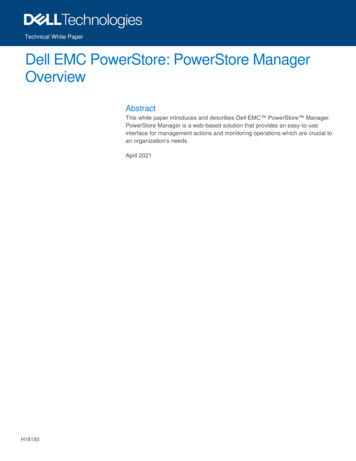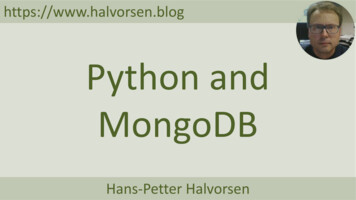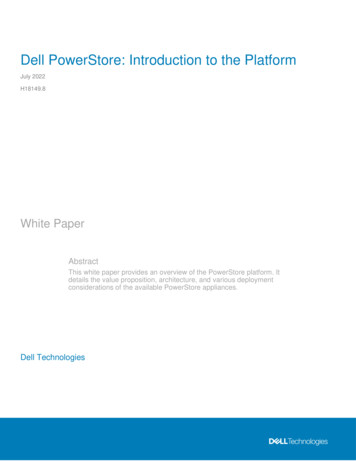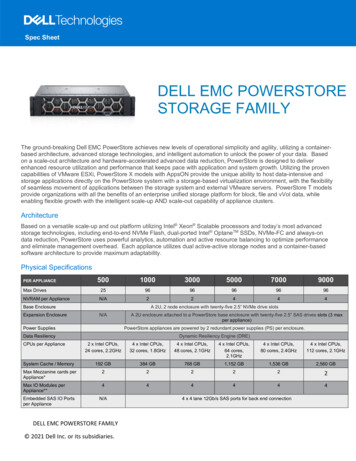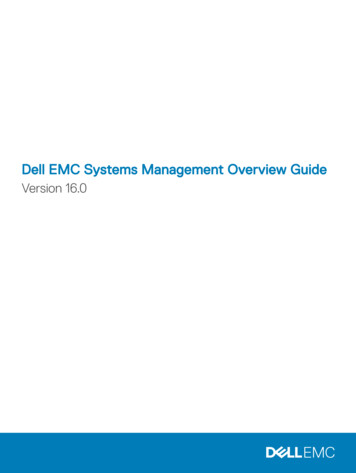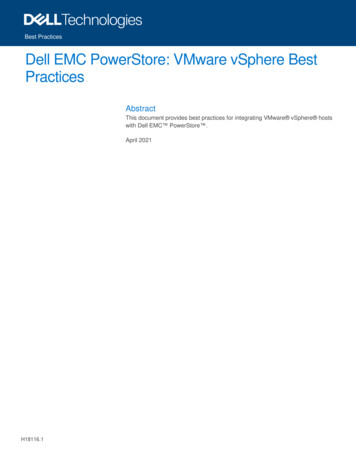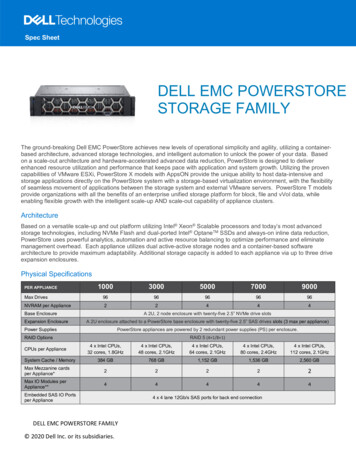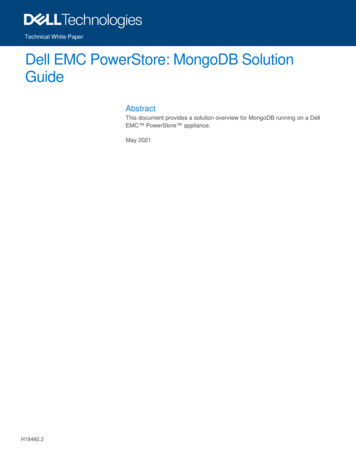
Transcription
Technical White PaperDell EMC PowerStore: MongoDB SolutionGuideAbstractThis document provides a solution overview for MongoDB running on a DellEMC PowerStore appliance.May 2021H18460.2
RevisionsRevisionsDateDescriptionFebruary 2020Initial releaseAugust 2020Solution guide with data reduction comparisonMay 2021PowerStoreOS 2.0 updatesAcknowledgmentsAuthor: Henry WongThis document may contain certain words that are not consistent with Dell's current language guidelines. Dell plans to update the document oversubsequent future releases to revise these words accordingly.This document may contain language from third party content that is not under Dell's control and is not consistent with Dell's current guidelines for Dell'sown content. When such third party content is updated by the relevant third parties, this document will be revised accordingly.The information in this publication is provided “as is.” Dell Inc. makes no representations or warranties of any kind with respect to the information in thispublication, and specifically disclaims implied warranties of merchantability or fitness for a particular purpose.Use, copying, and distribution of any software described in this publication requires an applicable software license.Copyright 2021 Dell Inc. or its subsidiaries. All Rights Reserved. Dell Technologies, Dell, EMC, Dell EMC and other trademarks are trademarks of DellInc. or its subsidiaries. Other trademarks may be trademarks of their respective owners. [5/28/2021] [Technical White Paper] [H18460.2]2Dell EMC PowerStore: MongoDB Solution Guide H18460.2
Table of contentsTable of contentsRevisions.2Acknowledgments .2Table of contents .3Executive summary.5Audience .51Introduction .61.1PowerStore overview .61.2MongoDB overview .61.2.1 Building a flexible scale-out distributed database architecture .71.2.2 Modern pluggable storage platform engines .81.3The advantages of MongoDB on PowerStore .91.3.1 AppsON brings MongoDB closer to the infrastructure and storage .91.3.2 Agile infrastructure, flexible scaling on a high-performing storage and compute platform.101.3.3 Mission-critical high availability and fault-tolerant MongoDB platform .101.3.4 PowerStore inline data reduction reduces storage consumption and cost .111.3.5 Efficient and convenient snapshot data backup .111.3.6 Secure data protection with ease of mind .121.3.7 Unified infrastructure and services management .121.3.8 MongoDB value and future expansion .121.4Terminology .122Sizing considerations .153Data reduction comparison .163.1Test environment topology .163.2PowerStore X appliance .163.2.1 MongoDB database hosts .173.2.2 PowerStore storage containers and virtual volumes .173.2.3 PowerStore X virtualization and performance best practices .193.3YCSB host .193.4Networking .193.5MongoDB installation and configuration .193.5.1 Operating system tuning.193.5.2 File system.203.5.3 MongoDB installation .213.5.4 MongoDB configuration .213Dell EMC PowerStore: MongoDB Solution Guide H18460.2
Table of contents3.645A4YCSB installation .22Test methodology and results .244.1Loading data with YCSB.244.2WiredTiger storage engine and compression.244.3Data ingestion .264.4Data reduction savings .274.5Data ingestion time .284.6MongoDB database VM CPU comparison .294.7MongoDB database VM memory comparison.304.8Test conclusion .30Data protection .325.1Snapshots and thin clones .325.2AppSync .335.3RecoverPoint for VMs .33Additional resources .34A.1Technical support and resources .34A.2MongoDB resources .34Dell EMC PowerStore: MongoDB Solution Guide H18460.2
Executive summaryExecutive summaryAs data becomes abundantly available and inexpensive to obtain in this data era, new opportunities emerge.Businesses and organizations make new discoveries and create new business models that are based onthese valuable data. New analytic applications like MongoDB are designed to be flexible and scalable, andwith the help of Dell EMC PowerStore , can harness this data growth and unlock the power of data.This paper offers a high-level overview of the PowerStore appliance and MongoDB. The document providesinsights about using various MongoDB compression libraries and the integrated PowerStore advanced datareduction feature. This paper is not a performance-focused study.AudienceThis document is intended for IT administrators, storage architects, partners, and Dell Technologies employees. This audience also includes individuals who may evaluate, acquire, manage, operate, or design aDell EMC networked storage environment using PowerStore systems.5Dell EMC PowerStore: MongoDB Solution Guide H18460.2
Introduction1IntroductionThis document was developed using the PowerStore X model appliance, MongoDB Enterprise Edition, andCentOS 7.x Linux. This section provides an overview for PowerStore and MongoDB, and discusses theircombined benefits.1.1PowerStore overviewPowerStore achieves new levels of operational simplicity and agility. It uses a container-based microservicesarchitecture, advanced storage technologies, and integrated machine learning to unlock the power of yourdata. PowerStore is a versatile platform with a performance-centric design that delivers multidimensionalscale, always-on data reduction, and support for next-generation media.PowerStore brings the simplicity of public cloud to on-premises infrastructure, streamlining operations with anintegrated machine-learning engine and seamless automation. It also offers predictive analytics to easilymonitor, analyze, and troubleshoot the environment. PowerStore is highly adaptable, providing the flexibility tohost specialized workloads directly on the appliance and modernize infrastructure without disruption. It alsooffers investment protection through flexible payment solutions and data-in-place upgrades.The PowerStore platform is available in two different product models: PowerStore T models and PowerStoreX models. PowerStore T models are bare-metal, unified storage arrays which can service block, file, andVMware vSphere Virtual Volumes (vVols) resources along with numerous data services and efficiencies.PowerStore X model appliances enable running applications directly on the appliance through the AppsONcapability. A native VMware ESXi layer runs embedded applications alongside the PowerStore operatingsystem, all in the form of virtual machines. This feature adds to the traditional storage functionality ofPowerStore X model appliances, and supports serving block and vVol storage to external servers.For more information about PowerStore T models and PowerStore X models, see the documents Dell EMCPowerStore: Introduction to the Platform and Dell EMC PowerStore Virtualization Guide.1.2MongoDB overviewMongoDB is a modern NoSQL database that uses a document-based data model to store both structured andunstructured data. It is highly scalable and can process massive amounts of data efficiently. A MongoDBdatabase can scale up to hundreds of systems with petabytes of data distributed across them. With a moderndatabase architecture comes the need for modern storage and application-driven infrastructure that isengineered to optimize and consolidate existing and new business use cases. The PowerStore storageplatform, together with the latest capabilities of MongoDB, introduces AppsON and a new era of onboardapplication support.MongoDB is engineered with replica sets to increase data availability and fault tolerance of the MongoDBservers. Full copies of the data are replicated to multiple secondary members. A single replica set supports upto 50 members. Using a larger number of replicas increases data availability and protection. It also providesautomatic failover of the primary member during planned or unplanned events such as server updates, serverfailures, rack failures, data-center failures, or network partitions. Replicating the data to a different server in adifferent data center further increases data availability and data locality for distributed clients. However,having too many replica members can lead to lower storage efficiencies, higher network-bandwidth usage,and increased management complexities. PowerStore can alleviate these challenges with its integrated datareduction feature, AppsON capability to bring applications closer to storage, and tight integration of thestorage platform and VMware virtualization environment.6Dell EMC PowerStore: MongoDB Solution Guide H18460.2
IntroductionPrimaryHeartbeatSecondarySecondaryA 3-member replica setA three-member MongoDB replica setBy default, the primary member is responsible for the write and read operations for the replica set. The clientscan specify a read preference to send read operations to the closest secondaries also. You can alsoconfigure a data-bearing member (a primary or secondary member but not an arbiter) to be hidden and serveas a backup copy if needed.As the workload grows, the primary or secondary members must be able to scale their processing capacity byadding CPU, memory, or storage. In a read-oriented workload, more secondaries, each with a full copy ofdata, might be required. To increase the data durability and to avoid data from being rolled back when aprimary member fails over, you can specify a write concern with a value of majority and enable journaling onall voting members. The write concern specifies how many members must acknowledge the write operationsbefore it is considered to be successful. The default write concern for replica sets is 1, which means that itonly requires the primary member to return a success acknowledgment after the member applies the writesuccessfully. When the write concern is set to majority, MongoDB calculates the required number of receivedacknowledgments from the members. WiredTiger journal is a write-ahead transaction log. The journal logspreserve all data modifications between checkpoints. When MongoDB fails between checkpoints, it uses thejournal logs to replay the changes since the last checkpoint.1.2.1Building a flexible scale-out distributed database architectureWith large datasets and high-throughput environments, MongoDB uses the sharding process to distributedata across multiple systems to increase storage capacity, throughput, and performance. A sharded clusterconsists of three components:Shards hold a subset of the data and are deployed as a replica set.Mongos process communications with the config servers and route the client requests to the appropriateshards.Config servers store the metadata for the cluster configuration settings.The config servers are deployed as a replica set. In a non-sharded database, there is only one primarymember in a replica set that is responsible for write operations. However, in a sharded cluster, each shardcan perform write operations respective to its dataset.7Dell EMC PowerStore: MongoDB Solution Guide H18460.2
IntroductionMongosquery routerMongosquery routerMongosquery routerConfigservers(replica set)Shard(replica set)Shard(replica set)Shard(replica set)Horizontal scalingA MongoDB sharded cluster1.2.2Modern pluggable storage platform enginesMongoDB supports a wide variety of traditional and business-critical workloads including both operational andreal-time analytics workloads. The MongoDB pluggable storage architecture extends new capabilities to thestorage platform depending on the different workloads. These storage engines are responsible for storing thedata and specify how the data is stored. Starting with version 4.2, MongoDB supports various storage enginesincluding the WiredTiger storage engine, the in-memory engine, and the encrypted storage engine. TheMMAPv1 storage engine was deprecated in version 4.2.The WiredTiger storage engine is the default and preferred storage engine for most workloads. It persistsdata on disk and provides features such as a document-level concurrent model, journaling, checkpoints, andcompression.The in-memory storage engine stores the dataset in the memory to reduce data-access latency but doesnot persist data on disk. It is available only in the MongoDB Enterprise Edition.The encrypted storage engine is the native encryption option for the WiredTiger storage engine. It providesencryption at rest and is only available in the MongoDB Enterprise Edition.It is possible to mix the different engines based on the use case in the same replica set. This capability allowsyou to optimize and meet the needs of specific application requirements in a way that benefits the specific8Dell EMC PowerStore: MongoDB Solution Guide H18460.2
Introductionengines. For example, you can combine the in-memory engine for ultralow latency operations with theWiredTiger engine for on-disk persistence.1.3The advantages of MongoDB on PowerStoreMongoDB is a modern distributed database that requires a powerful, highly scalable, and flexibleinfrastructure. PowerStore is performance-optimized for any workload, and its adaptable platformcomplements modern distributed databases such as MongoDB. This section highlights the PowerStorefeatures that benefit and extend the MongoDB environment.1.3.1AppsON brings MongoDB closer to the infrastructure and storageBringing applications closer to the data increases density and simplifies infrastructure operations. ThePowerStore AppsON capability integrates with VMware vSphere , resulting in streamlined management inwhich storage resources plug directly into the virtualization layer. Using VMware as the onboard applicationenvironment results in unmatched simplicity, since support is inherently available for any standard VM-basedapplications. When a new PowerStore X model is deployed, the VASA provider is automatically registered,and the datastore is created, eliminating manual steps and saving time. PowerStore seamlessly integrates theVMware ESXi software into the same hardware. Two ESXi nodes are embedded inside the appliance whichhas direct access to the same storage resources. This close integration allows applications like MongoDB totake full advantage of server and storage virtualization with simplified deployment and management. AppsONis available on the PowerStore X model exclusively.VMVMVMVMVMVMESXiESXiDrive array enclosureAppsON with embedded ESXi in the PowerStore X model applianceEmbedded ESXi in PowerStore X appliance9Dell EMC PowerStore: MongoDB Solution Guide H18460.2
Introduction1.3.2Agile infrastructure, flexible scaling on a high-performing storage and computeplatformPowerStore provides flexible scaling with ease of management that compliments the MongoDB scale-up andscale-out distribution model. The integrated hypervisor dynamically scales up the replica set members whenthe workload requires it, while new replica sets, or shards, can be provisioned rapidly on the same or onadditional appliances in a different location.When the application grows and requires more storage from a PowerStore appliance, administrators canscale up the storage capacity by adding disk expansion enclosures without service interruption at any time.Multiple PowerStore appliances can also be configured into a cluster to increase CPUs, memory, storagecapacity, and front-end connectivity. Clustering simplifies and centralized the management of multipleappliances from a single HTML5-based management interface. A cluster can comprise up to four PowerStoreT appliances or four PowerStore X appliances. The support of clustering multiple PowerStore X appliances isintroduced in PowerStoreOS 2.0. Each appliance within the cluster can have different configurations of CPUs,memory, NVMe drives, and expansion enclosures. For more information about PowerStore cluster, see thedocument Dell EMC PowerStore: Clustering and High AvailabilityA single PowerStore appliance can scale up to 112 vCPUs, 2.5 TB of memory, and 3.59 PB raw storagecapacity. The NVMe architecture is designed for the next-generation NVMe-based storage and takesadvantage of low-overhead NVRAM cache. PowerStore is engineered to handle the most demandingMongoDB mixed workloads.1.3.3Mission-critical high availability and fault-tolerant MongoDB platformAt the hardware level, PowerStore is designed to be highly available and fault tolerant. It monitors the storagedevices continuously and automatically relocates data from failing devices to avoid data loss. The PowerStoreX model appliance includes two ESXi nodes and redundant hardware components. The non-disruptiveupgrade (NDU) feature further increases overall PowerStore availability. The updates are performed on thenodes in a rolling fashion. NDU supports PowerStore software releases, hotfixes, and hardware and diskfirmware.To support high-value business workloads and service requirements on the application level, it is essential toprotect and ensure the availability of the primary member of a replica set. When the primary member of areplica set becomes inaccessible, the replica set cannot process any write operations until the primarymember recovers or a new primary is elected. Furthermore, the election requires most of the members to beavailable.With standard VMware vSphere High Availability (HA) integrated into PowerStore, the embedded VMwareESXi hypervisor automatically restarts or migrates failed MongoDB servers to a different ESXi node toresume operations. This helps to restore MongoDB to its full operation capacity and minimizes the chance ofthe database going offline or read-only.To achieve an even higher level of redundancy and application availability, you can deploy the MongoDBreplica set and sharded cluster across multiple PowerStore appliances in different data centers. PowerStoreimproves MongoDB availability and provides unparalleled flexibility and mobility to relocate and move acrossdata centers and appliances.10Dell EMC PowerStore: MongoDB Solution Guide H18460.2
IntroductionShard AShard AShard APrimarySecondarySecondaryShard BShard BShard BSecondaryPrimarySecondary N N NVMVM NVMVM NVMVMVMware ESXiVMware ESXiVMware ESXiNVMe storageNVMe storageNVMe storage NGeographically distributedMongoDB shardedclusteron multipleGeographicallydistributedshardedcluster PowerStore X model appliances1.3.4PowerStore inline data reduction reduces storage consumption and costAs business data continues to grow, big data has become a critical component in the business analyticsworld. A tremendous amount of data is pulled from all kinds of sources continuously and run through cloudscale applications like MongoDB to gain insights into customers and businesses. When putting MongoDBreplica sets on PowerStore, the always-on inline data reduction feature greatly reduces the actual storageused but still maintains the application data availability and protection that is expected from MongoDB.1.3.5Efficient and convenient snapshot data backupPowerStore provides MongoDB with additional data protection through array-based snapshots. A PowerStoresnapshot is a point-in-time copy of the data. The snapshots are space efficient and require seconds to create.Snapshot data are exact copies of the target data and can be used for application testing, backup, orDevOps. Because of the tight integration with VMware vSphere, PowerStore can take vVol-based VMsnapshots directly from PowerStore Manager using a protection policy schedule or on demand. When takingthe VM snapshots from vSphere, it passes the request to PowerStore to create the vVol-based VM snapshotswhich have no performance impact on the VMs. You can view the VM snapshot information in PowerStoreand vCenter.11Dell EMC PowerStore: MongoDB Solution Guide H18460.2
Introduction1.3.6Secure data protection with ease of mindWith high-value data driving business applications, data security is a top concern for all organizations. Lost orstolen data can seriously damage the reputation of an organization and result in huge financial costs and lossof customer trust. Dell Technologies engineered PowerStore with Data at Rest Encryption (D@RE) whichuses self-encrypting drives and supports array-based, self-managed keys. Once activated, data is encryptedas it is written to disk using the 256-bit Advanced Encryption Standard (AES). PowerStore D@RE providesthis data security benefit to MongoDB while eliminating application overhead, performance penalties, andadministrative overhead that is typically associated with software-based solutions.1.3.7Unified infrastructure and services managementPowerStore provides deep integration with VMware management tools and services with Dell EMC VirtualStorage Integrator (VSI), VMware vRealize Operations Manager (vROps), VMware vRealize Orchestrator(vRO), and VMware Storage Replication Adapter (SRA). You can easily incorporate ESXi on PowerStore Xmodels into your existing vCenter and manage all VMware infrastructure and services from a unifiedmanagement platform.1.3.8MongoDB value and future expansionNew business analytics applications like MongoDB are fundamentally changing the way data is used tosupport the business. Massive amounts of data and technology innovation together provide the opportunityfor organizations to transform. As the value and scale of this data grows, it is critical to have a future-proofplatform that is easy to manage, provides technical innovation for future growth, and can support theapplication architecture. MongoDB on PowerStore brings IT organizations the ability to be agile, efficient, andresponsive to business demands.1.4TerminologyThe following terms are used with PowerStore.Appliance: Solution containing a base enclosure and attached expansion enclosures. The size of anappliance could be only the base enclosure or the base enclosure plus expansion enclosures.PowerStore node: Storage controller that provides the processing resources for performing storageoperations and servicing I/O between storage and hosts. Each PowerStore appliance contains two nodes.Base enclosure: Enclosure containing both nodes (node A and node B) and 25 NVMe drive slotsExpansion enclosure: Enclosures that can be attached to a base enclosure to provide additional storage.Fibre Channel (FC) protocol: Protocol used to perform SCSI commands over a Fibre Channel network.iSCSI: Provides a mechanism for accessing block-level data storage over network connections.NDU: A non-disruptive upgrade (NDU) updates PowerStore and maximizes its availability by performingrolling updates. This includes updates for PowerStore software releases, hotfixes, and hardware and diskfirmware.NVMe: Non-Volatile Memory Express is a communication interface and driver for accessing non-volatilestorage media such as solid-state drives (SSD) and SCM drives through the PCIe bus.12Dell EMC PowerStore: MongoDB Solution Guide H18460.2
IntroductionNVRAM: Non-volatile random-access memory is persistent random-access memory that retains data withoutan electrical charge. NVRAM drives are used in a PowerStore appliance as additional system write caching.Volume: A block-level storage device that can be shared out using a protocol such as iSCSI or FibreChannel.Snapshot: A point-in-time view of data that is stored on a storage resource. You can recover files from asnapshot, restore a storage resource from a snapshot, or provide access to a host.Storage container: A VMware term for a logical entity that consists of one or more capability profiles andtheir storage limits. This entity is known as a vVol datastore when it is mounted in vSphere.PCIe: Peripheral Component Interconnect Express is a high-speed serial computer expansion bus standard.PowerStore Manager: An HTML5 management interface for creating storage resources and configuring andscheduling protection of stored data on PowerStore. PowerStore Manager can be used for
VMware vSphere Virtual Volumes (vVols) resources along with numerous data services and efficiencies. PowerStore X model appliances enable running applications directly on the appliance through the AppsON capability. A native VMware ESXi layer runs embedded applications alongside the PowerStore operating
